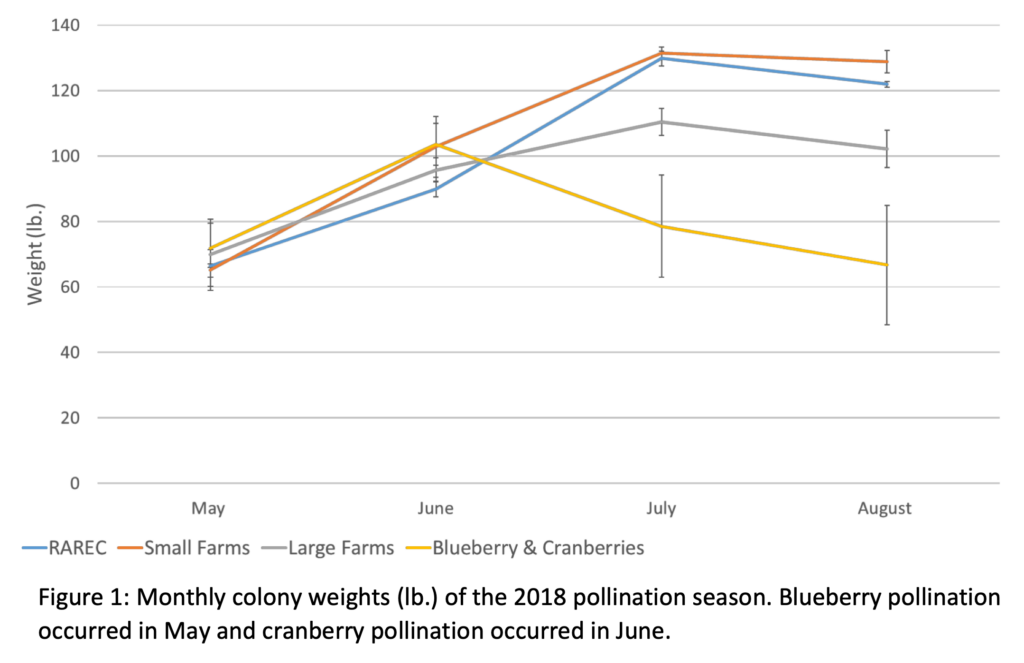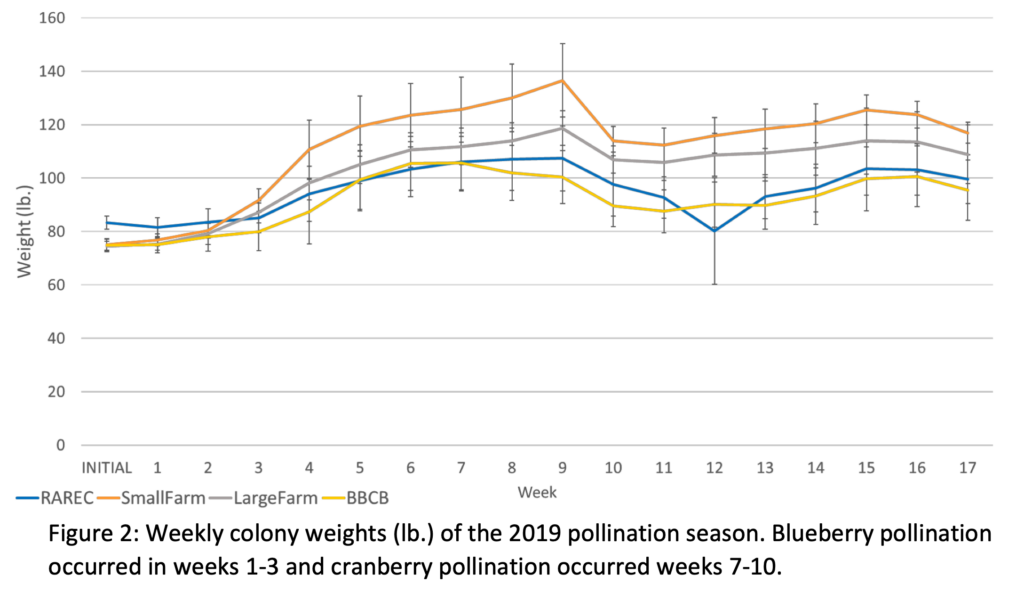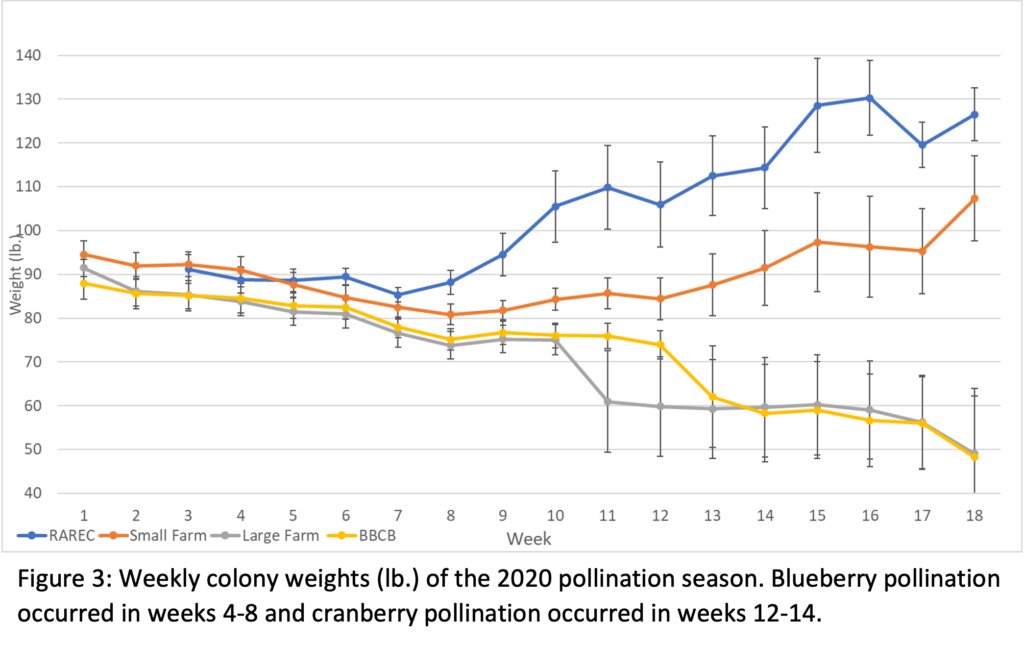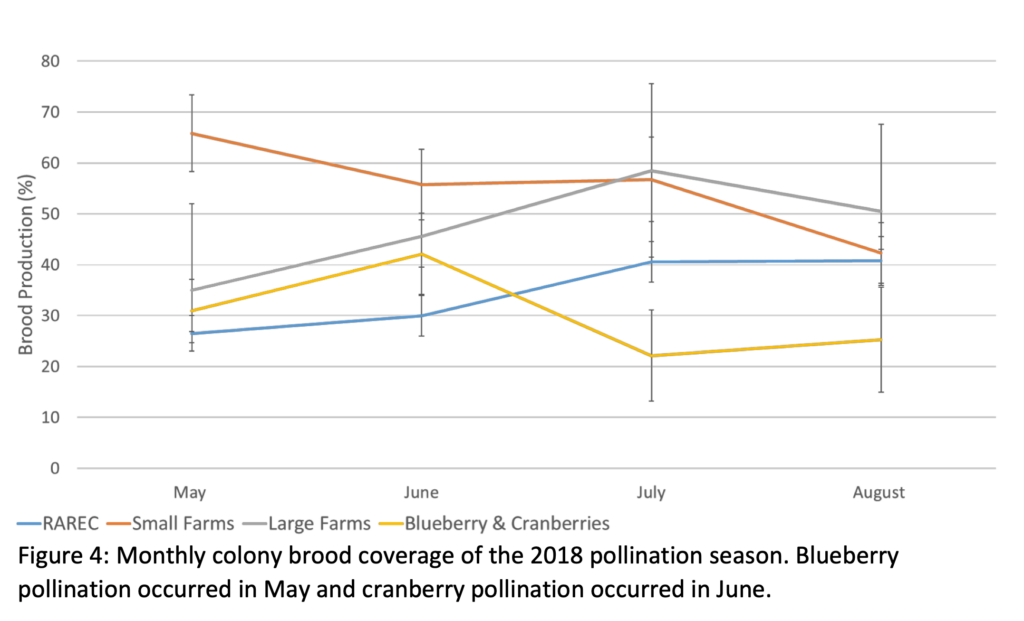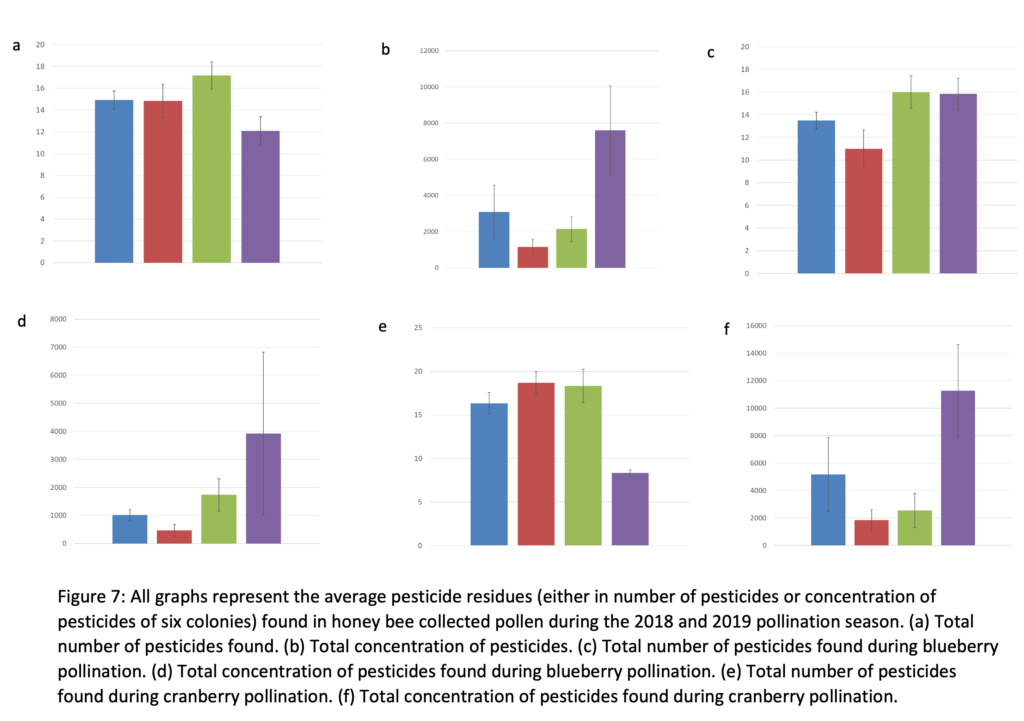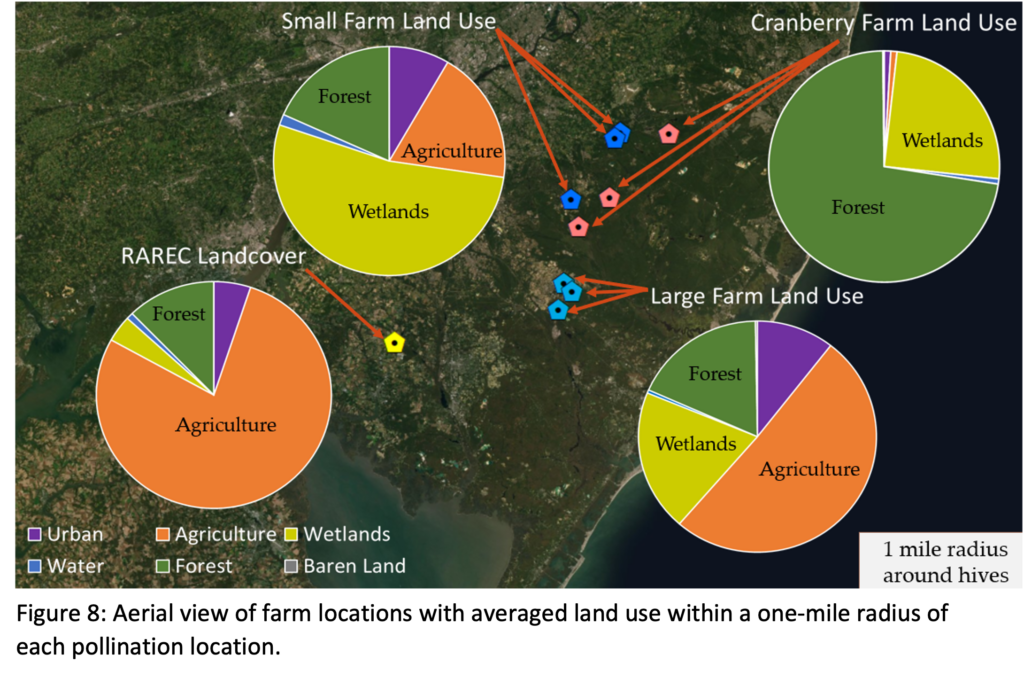Final report for LNE18-364
Project Information
Highbush blueberries and cranberries require pollination services for successful production. Annual New Jersey (NJ) production averages a value of $80 million, produced on 110 blueberry farms and 30 cranberry farms. At 2 hives per acre and 8,500 acres, blueberries alone require 17 to 18,000 hives for pollination. Blueberries are susceptible to diseases that are treated during bloom. Several prebloom and postbloom insecticides are also used. Nineteen NJ beekeepers, and several out of state beekeepers provide pollination services from late April through May in blueberries, then remove bees to holding yards before placing them in cranberries. Over the last 5-6 years commercial beekeepers have experienced hive decline, shrinking brood, brood gaps, brood death, queen death and excessive replacement. Commercial beekeepers have estimated that colony decline during this period has led to over $1.4 million in annual losses. This in turn leads to higher pollination prices to the grower and lower quality hives. Varroa mites, pesticide residues and disease further complicate the combined stress a colony may experience. This project targeted commercial blueberry growers and beekeepers who pollinate those farms, and also looked at the effect on the colonies of following blueberry pollination with cranberry pollination. Anthracnose disease is a key blueberry disease that causes rotten fruit, and must be controlled during the bloom stage of the crop.
The research approach was to establish monitored colonies in 4 pollination treatments, monitor the hive health during and after pollination, take pollen samples from foragers and analyze for various pesticide residues that may enter the hive. The results showed that while numerous pesticides are brought back to the hive, many but not all are from use in blueberries. Some residues are already present in the hive from varroa mite control and from other foraging behavior. However some of highest concentrations were active ingredients in fungicides used in blueberries. This finding has led to additional research being done on the effects of these fungicides on brood growth and development. Total hive health was better when bees were placed on small isolated farms than on large aggregated farm sites. Both beekeepers and fruit growers attended educational meetings where project information was presented totaling 2160 audience contacts and another 1440 individual consultations. A set of best practice recommendations was developed for both growers and beekeepers to follow in order to help mitigate the negative effects of these pesticides, and published in the 2022 Commercial Blueberry Pest Control Recommendations (in press), along with bee safety section also included in the 2020 and 2021 editions.
- Twenty fruit growers, producing fruit on 3,000 acres, will reduce applications of bee toxic insecticides, and replace with alternatives that result in decreased pesticide residues in hives.
- Three beekeepers, with improved colony management plus lower hive residues will see a 30% increase of brood growth from overwintered levels, as measured by percent brood coverage in monitored hives, and compared to baseline data gathered prior to the start of this project.
Problem and justification- New Jersey is a leading blueberry and cranberry production state. National highbush blueberry and cranberry production is over $1 billion (USDA/APHIS, 2017). Honey bees pollinate the $90-$100 million NJ blueberry and cranberry crops, where during the last 5-6 years beekeepers have seen a decrease in hive strength, reduced brood, and queenless and dead colonies. One NJ beekeeper stated that 90% of his Florida colonies used for NJ pollination were dead by February, while colonies kept in Florida had about 20% mortality (Ham, pers com. 2017). Both crops have required a high degree of pesticide use, which beekeepers attribute as the major cause of colony decline. As colony losses increase, pollination fees increase and the quality of pollinating hives goes down. In 2012 blueberry pollination fees were $60 per hive, and by 2017 fees were $90 per hive. Costs for cranberry pollination were over $100/hive. Blueberry requirements average 2 hives per acre but often 3-4 hives is used per acre for pollination, as is the case for cranberries. Total hive requirements exceed 18,000 hives from NJ-based and other migratory commercial beekeepers. Because of the cost and need for bees, both commercial fruit growers and beekeepers have a vested interest in the continued health of honey bees.
Solution and approach – This project focused on examining pesticide residues in pollinating hives, correlating residues with colony health measurements, and standard beekeeper practices; and changing fruit grower pest management practices that can reduce residues, thereby improving colony health. It evolved from meetings that beekeepers organized with fruit growers and extension/researchers. Three grower clientele groups have funded pilot investigations – blueberry growers, cranberry growers, and beekeepers. We used Rutgers managed hives and commercial hives. Colonies were measured for brood growth, queen presence, diseases, parasitism, and pesticide residues. Bee Informed Partnership (BIP) measurement protocols were used for measuring hive health, along with BIP management recommendations. Parasitism and disease diagnostics were submitted to the UMD/USDA APHIS through BIP in year 1. Fruit growers adhered to known bee safety and pesticide use recommendations, and supplied annual pesticide use records. Resulting data formed the basis for changes in pesticide use, while other analyses of hive health led and are leading to changes in colony management. For example, frequency of varroa or disease treatments or other management practices close to pollination periods, and hive removal methods at the end of pollination.
Cooperators
- (Researcher)
- (Researcher)
Research
1) Pesticides used close to or during bloom negatively affect brood growth, survival, and queen longevity, and often in combination with other stress factors.
2) Hives used for pollination services on small isolated farms, often have fewer and lower pesticide residue levels compared to those found in large diverse cropping areas.
3) Changes in pest management practices can reduce the number of pesticide residues present in honey bee colonies.
4) Fruit growers and beekeepers can together reduce pesticide and other stress factors, resulting in improved colony health.
Methods – Hive Weights and Hive Health
There were 4 treatments: 1) blueberry pollination only on large farms (>200 acres), 2) blueberry pollination only on small farms (< 100 acres) surrounded by woods, 3) blueberry pollination on large farms followed by cranberry pollination, and 4) No pollination services, staying at the Rutgers Agricultural Research & Extension Center (RAREC). Each treatment had three replications and three hives per replication – total 9 hives per treatment. Hives were transported on small trailers and remained undisturbed, except for taking data. Brood coverage was determined by estimating the percent of brood covering the same three frames (front and back) located within each hives brood box. Three frames in each hive were numbered at the beginning of the season so that brood coverage could be determined using the same 108 frames (36 hives x 3 frames in each hive) throughout the experiment. Hive weight was taken weekly.
Queen rightness is determined by the presence of eggs within a hive. If a hive has no eggs, then it is considered a dead hive. If a hive was determined to be dead, then a new queen was introduced to the hive to be able to continue experiment.
Pollen samples were collected near the end of each pollination period. Pollen used in pesticide residue analyses were collected by honey bee foragers for a total of four times (during blueberry and cranberry pollination in 2018 and 2019) from 24 colonies (1 colony in each farm replicate each year) and analyzed by the USDA lab in Maryland using a 199 pesticide residue chemical analysis. Pollen was collected from foragers using bottom mount 10 frame type hive entrance pollen traps. Samples were collected in 2020 and 2021 and sent to Cornell University for analyses (results in progress). During 2021 sequential, daily pollen samples were collected immediately following fungicide applications to examine residue levels correlated with time after application.
The combined biological measurements taken to measure hive health are being formulated into a calculation to measure hive health, termed in this project the "Hive Health Index" or HHI. The HHI is being developed as a single index to make it easier to define the effects of various stressors on resulting hive health. The HHI has a scoring system from "0" to "3", with the higher the number, then the better the hive health.
Behavioral Tests – Methods
Based on the pesticide residues found, the grower spray records, and state recommendations, we conducted a series of behavioral tests to examine the effects if any, that fungicides may have on foraging behavior and resulting hive health. After an initial “training period,” 5 frame nucleus hives were set in a flight tunnel, and foraging bee visits were compared using small feeder, control using sucrose syrup alone, with treatments laced with various field rates of fungicides. Fungicide laced feeders contained the following treatments:
- Ziram
- Azoxystrobin (Abound)
- Difenconazole (Quash)
- Cyprodinil + Fludioxonil (Switch)
- Boscalid (Pristine)
Five-framed hives with approximately 3,000 bees in each were trained to feed on two separate but identical feeders. After three days of successful feeding the tests began.
Treatment feeders were identical, made from opaque plastic cups with lids, and approximately 50 holes (1 mm in diameter) evenly dispersed just below the lid of each container. They were placed in separate aluminum pie pans to catch run-off, and on two separate concrete blocks evenly distributed in a straight line and at the opposite end of the colony within a flight tunnel.
On the morning of each daily run, each feeder was filled with the appropriate treatment diet and weighed before and after each run to determine consumption rate. An experimental run consisted of 30-minute visual observations where the number of foragers visiting each feeder was recorded. Two runs were conducted each day per experiment and continued for 5 consecutive days, unless weather (rain) prevented foraging during the visual observation. Appropriate treatment diets were measured and replaced if the feeder was depleted prior to the 2nd run of each day. After the five-day experimental run was completed, colonies were inspected for health indicators to identify adverse effects of each treatment and used for comparison in behavior response analysis. Each experiment was repeated four times over five weeks using new colonies each week. To ensure that there was no bias in feeder location, the feeders were placed in a new location each day (i.e., if treatment feeder was on the left the first day of the experimental run, the next day the feeder would be placed on the right).
Historical Pesticide Use as an Impact to Hive Health and Project Impact
Earlier in the project 6 grower pesticide use use records, consisting of 10 farm sites, were examined for the types of fungicides and the number of applications used during the bloom/pollination period. This data was taken every 5 years starting in 1995 and continued during this project. Research done in the late '90s defined how the anthracnose fungus overwintered, and led to an increase in fungicide use from 2000/2005 onward. Since beekeepers had stated a marked increase in colony decline during this period, it became part of the basis for hypothesis that fungicide use was affecting hive health. Some of the measurements regarding the impact of this project would be the effective messaging to growers, resulting changes in fungicide use (number of applications, application methods, timing, types of pesticides used, and the number of growers willing change practices).
Three consecutive years following new colonies of honey bees each year at the same farms revealed that colonies which pollinated in small blueberry farm settings produced more honey and brood than colonies which pollinated in diverse (RAREC), large blueberry, and cranberry settings (Figures 1-6). Colonies that pollinated blueberry and cranberry farms (BBCB) produced the least amount of honey and brood. In 2020, when the RAREC site was exposed to very little pesticides, both large farms and the BBCB treatments were still unable to recover from blueberry pollination despite having ample foraging resources and reduced exposure to pesticides.
Pesticide residues found within pollen, collected via honey bees during blueberry and cranberry pollination in 2018 and 2019, showed that large farm colonies were exposed to the highest number of different pesticides (Figure 7a) while BBCB colonies possessed the highest concentration of pesticides (Figure 7b). The pollen which was collected during blueberry pollination showed that small farms had the least number of pesticides present and had the lowest concentration pesticides (Figures 7c and 7d). Pollen collected during cranberry pollination resulted in BBCB colonies having the least number of pesticides but the highest concentration of pesticides (Figures 7e and 7f). RAREC colonies were placed on a research farm where many crops and bee forage were planted, but where tree fruit is grown and pesticide testing takes place. Pesticide exposure varied greatly on that site, and even though the bees had a surplus of foraging resources, colony weights and brood production varied from year to year seemingly depending on pesticide exposure. Because of the Covid pandemic, there was very little pesticide use on the RAREC site in 2020, and hive health reflected by weight was good (see Figure 3). Results from the 2020 residue samples show that the RAREC site had some of the lowest amounts of fungicides labeled in blueberries, and that hives at some large blueberry farm sites had the highest levels fungicides used in blueberries, and had relatively poor hive health. Samples from 2021 are still being analyzed. In 2020 the actual reduction in pesticide use at the RAREC site was reflected in heavier hives and an increase in overall hive health.
These results show that colonies which are subjected to large scale blueberry and cranberry pollination are exposed to more pesticides and/or higher concentrations of pesticides. Colonies that were in the large farm and BBCB treatments were weaker than the other two treatments in all three years. These results suggest that increased exposure to pesticides has a negative impact on colonies. However, colonies in small farms and at RAREC had access to a greater variety of foraging resources (throughout the entire study), which can play a role in colony weights and brood production. Thus, further research is needed to conclude that pesticides are the major factor negatively influencing colonies. This study presents the following new questions: Which has a greater negative impact on honey bee colonies: the concentration of pesticides or the number of different pesticides? Would an increase in nutrient diversity (foraging resources) have a positive impact on colonies during blueberry bloom?
Pesticide Residues – Pollen samples showed that up to 45 various pesticide residues were present in the colonies. These included several herbicides, 15 – 17 fungicides and 17 - 20 insecticide/miticides, depending on the year and location. Five of the insecticide/miticides were directly attributable to beekeeper use in varroa management. Pollen data was summarized in previous reports.
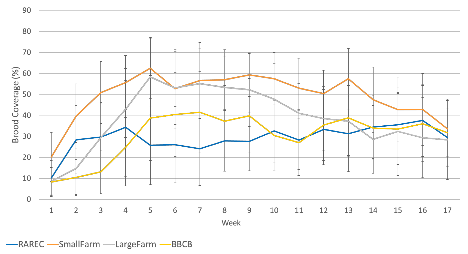
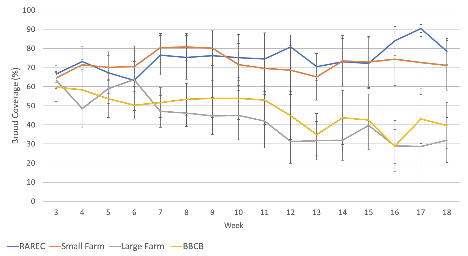
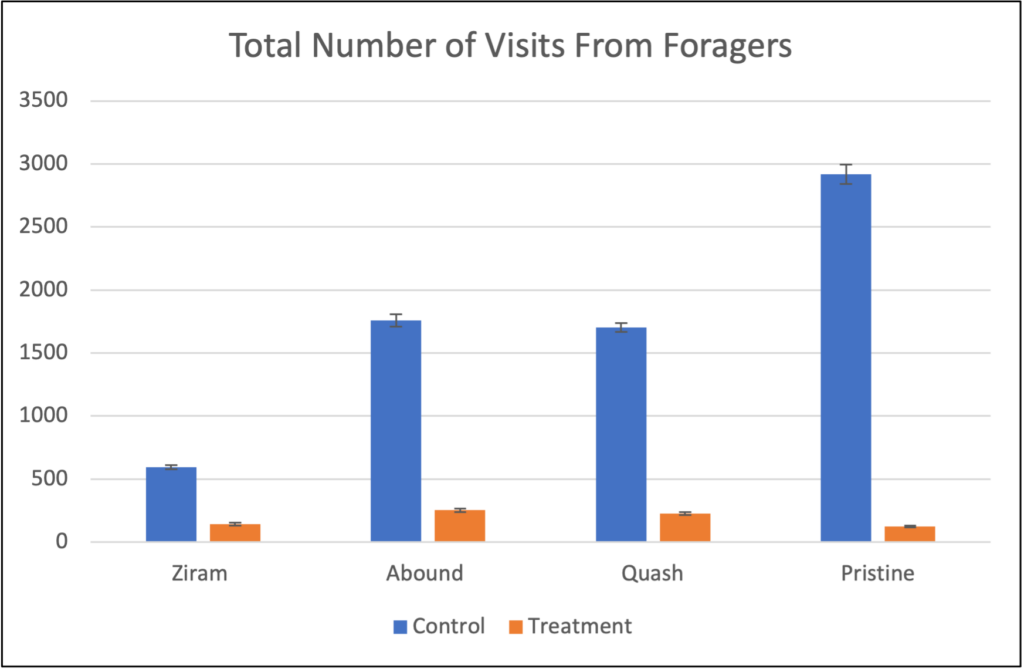
Behavioral Tests
Fungicide treated feeders had a significant effect on foraging behavior. Foragers visited fungicide treated feeders much less than feeders with plain sugar syrup (Figure 9). When those hives with bees that visited fungicide treated feeders were examined for hive health, those with bees that foraged on Switch and Ziram treated feeders had the lowest weight and poorest distribution of brood. This work is ongoing and will be repeated in 2022 with freshly treated potted blueberry bushes in place of feeders alone. The results from this study imply that freshly treated bushes may be less attractive to foragers than untreated bushes. The results could have a profound impact on grower spray practices, hive management and colony health.
Pesticide Use Records as Coinciding with A Decrease in Colony Health and as a Measure of Program Impact
An examination of historical pesticide use was extracted from the same 6 grower records operating 10 farm sites back to 1995 and analyzed at 5 year intervals plus 2021, since this was the last year of the project, and would have allowed maximum program impact. Figure 10 illustrates the average number of applications used by sampled growers during these years.
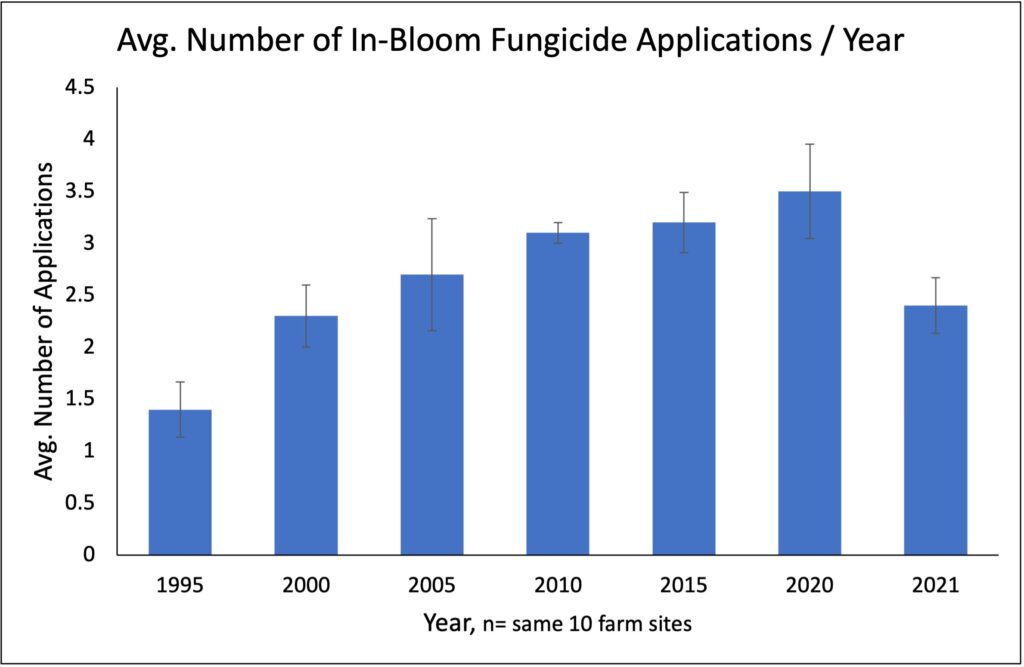
Commercial beekeepers first requested help in mitigating colony decline in 2014. The closest survey year to this is 2015. Figure 11 illustrates the difference in the number of in-bloom application between 2015, or 2 years before the project started, vs. 2021. Therefore we showed a 25% decrease in fungicide use from just before the project vs as the project ended (significant @P=.057).
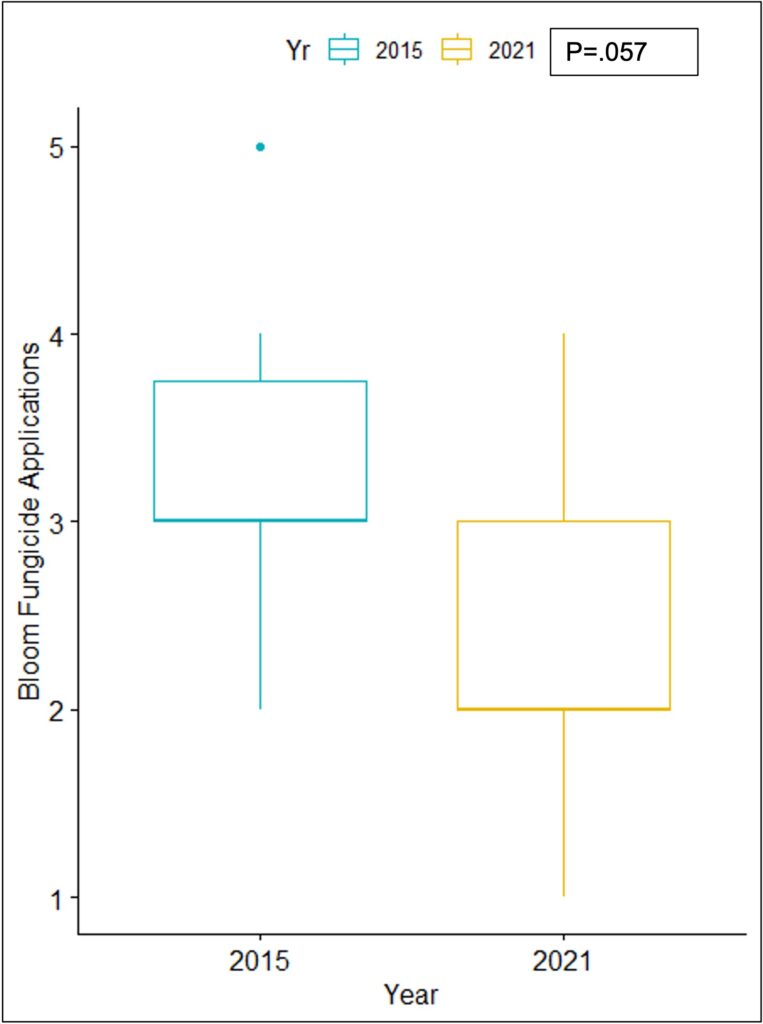
The hive health index (HHI), being developed as part of this project, was calculated from the hive health measurements taken during 2019, 2020 and 2021. The index was compared between 2020 and 2021, or the years when the number of fungicide applications decreased during the life of the project. The increase in the HHI is shown in figure 12.
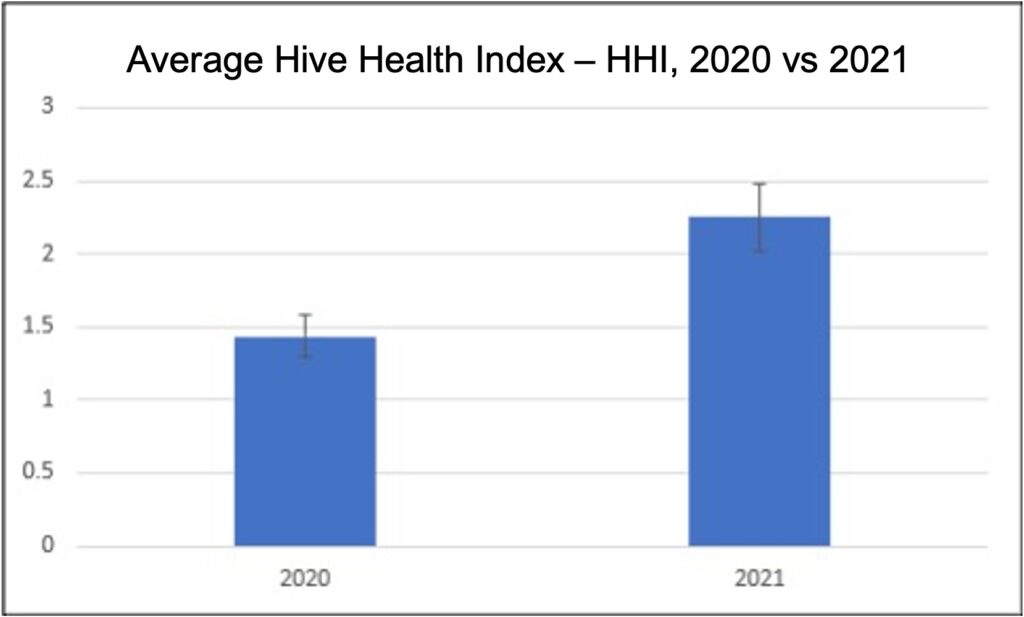
January 2022 Research conclusions
- Colonies exposed to double pollination, or blueberry pollination for 4 weeks, followed by 1 week rest, then cranberry pollination, experienced poor brood growth. In fact, colonies in this treatment suffered from a decrease in hive health as measured by total brood coverage and hive weights.
- Colonies used for blueberry pollination on large acreage blueberry farms and areas surrounded by blueberry farms, experienced an initial growth during the pollination period, but then went backwards shortly after pollination in terms of brood coverage and hive weights.
- Colonies placed on small isolated blueberry farms showed an increase in hive weights and brood coverage throughout the season. Small isolated farms exposed bees to fewer pesticide applications, but the bees are also placed in an area of more varied diet, so foraging resources are more diverse than those found on large aggregate farm sites. This may also contribute to improved hive health.
- Colonies not placed in pollination service but remaining at a research farm (a sprayed area), showed variable results from year to year. Due to the COVID pandemic in 2020 there were few pesticide sprays applied that year in the non treatments site (RAREC). Colonies that gained the most weight and increase in brood coverage were from this “non pollination” treatment in 2020.
- Pollen samples showed up to 45 different active ingredient pesticide residues. These varied depending on the crop, farm size and location, but larger aggregated farm sites tended to have more types of active ingredient residues. The highest concentrations of specific residues were found in hives coming out of cranberries used for double pollination services - blueberries to cranberries.
- Behavior studies indicate that foragers prefer not to visit a fungicide treated food source, and that fungicide treated syrup also affected colony growth. This was an added part of the study and will be expanded during 2022.
- Resulting hive health combined with pesticide use data and grower interviews indicate that colony decline during pollination can be mitigated. While we have illustrated that this is likely due to decreasing the number of fungicide applications, we have yet to link this with the actual residues in pollen and in the hive. The 2021 residue samples are being analyzed as of this writing. Colony health is expected to improve as growers follow the recommended practices that were developed during the life of this project, and in collaboration with both beekeepers and fruit growers. This illustrates how beekeepers and fruit growers can work together to try to reduce pesticide and other stress factors on honey bees. (Education section milestone 9).
Education
Formal educational activity during the entire project, including activities held during the first 2 years, reached 2,595 clientele through 25 meetings and 1746 students and professionals through seminars and professional meetings.
In 2021 we conducted 10 educational meetings which reached 1307 clientele, consisting of 541 grower contacts and 766 beekeeper contacts.
During late 2020 we reached 584 student and professional contacts through 8 professional meetings and seminars.
These events are listed below:
2021 Cooperative Extension Meetings & Classes
03/18/21 “Update on the Relationship Between Honey Bee Health and Blueberry Pest Management.” Chelsea Abegg, Blueberry Open House. 136 blueberry growers and industry. (Webinar).
03/09/21 “Effects of Blueberry and Cranberry Pest Management Practices on Honey Bee Hive Health.” South Jersey Chapter, New Jersey Beekeepers Meeting. 61 beekeepers.
04/11/21 “Factors Influencing Hive Health in Pollination Practices.” New Jersey Beekeepers Invited Meeting. 416 beekeepers (Webinar)
04/22/21 “Early Season Pesticide Use Around Bees.” Atlantic and Burlington County Blueberry Twilight Meeting. 66 growers and industry. (Webinar).
11/19/21 “Colony Collapse Issues with NJ Blueberry Pollination.” South Jersey Chapter, New Jersey Beekeepers Meeting. 68 beekeepers.
Formal Clientele Outreach in 2021 - 747
2020 Cooperative Extension Meetings & Classes
01/15/20 “Research & Education to Reduce Bee Losses During Pollination and Honey Production” Delaware Beekeepers Association, Delaware Ag Week, Harrington, DE. 112 beekeepers and farmers.
02/01/20 “Update on Pesticide Impacts on Honey Bees Used for NJ Highbush Blueberry Pollination,” The New Jersey Beekeepers Association Annual Winter Meeting, Columbus, NJ. 165 beekeepers.
02/05/20 “Update on Pesticide Impacts on Honey Bees Used for NJ Highbush Blueberry Pollination” New Jersey Agricultural Convention and Trade Show, Atlantic City. 98 blueberry growers.
03/09/20 “Details on Honey Bee Health Studies” Blueberry Open House, 89 growers and industry. (Webinar).
03/26/20 “Blueberry Update for March 26, 2020 IPM Update and Pollination” Blueberry Twilight Meeting, 96 growers and industry. (Webinar).
Formal Clientele Outreach in 2021 - 560
Commercial, students and professional outreach
02/2021 “”The Bugs and the Bees.” Rutgers Geology Museum, Ask a Geologist Series. 53 elementary school students.
03/2021 “Factors Influencing Honey Bee Hive Health in Blueberry Farms.” ESA Eastern Branch Meetings 36 students and faculty
03/2021 “6 Meetings and seminars with ISCA and BVT personnel totaling 72 contact hours.
08/2021 “Blueberry Fungicide Impacts on Honey Bee Foraging Behavior & Colony Health” Rutgers graduate student colloquium. 76 students and faculty.
11/2021 “Blueberry Fungicide Impacts on Honey Bee Foraging Behavior & Colony Health.” Entomological Society of America National Meeting. 143 entomologists & graduate students.
12/2020 “Effects of Blueberry & Cranberry Pest Management Practices on Honeybee Hive Health.” Cumberland-Shenandoah Fruit Workers Conference. 57 professional entomologists and graduate students.
11/2020 “Effects of Blueberry & Cranberry Pest Management on Hive Health.” Entomological Society of America National Meeting. 101 students and entomology professionals.
08/2020 “Blueberry and Cranberry Pollination Services - Impacts on Colony Health” Rutgers graduate student colloquium. 46 students and faculty.
Formal Student and Professional Outreach in 2020-21 - 584
Milestones
1. During 2018, 100 fruit growers will participate in a knowledge survey about the use of pesticides close to and during bloom periods. The survey will focus on fruit grower pest management practices used just prior to, during and shortly after bloom. Survey results will form a baseline for grower perception and understanding of pesticides and issues encountered by beekeepers, and later compared to a similar survey completed during the fall and early winter of 2020 (see milestone 9).
100
170
December 31, 2018
Completed
February 05, 2020
The survey, along with teaching activities were given during 2 meeting events during the NJ Agricultural Convention on February 6, 2019 and the Blueberry Open House on February 19, 2019. The follow-up in person survey could not be administered due to the pandemic, which prevented in-person contact during the later half of 2020 and all of 2021. However, this was supplemented by individual field visits with growers, interviews and web based presentations.
2. Forty blueberry growers and 10 cranberry growers will be surveyed for pesticide use data for the years preceding the project. These data will provide baseline information about actual grower pesticide use as it relates to pollination issues.
45
40
December 31, 2018
Completed
December 31, 2019
Forty grower pesticide records were collected at the end of 2018, 2019, 2020 and 2021. These were analyzed for pesticide used just before, during, and just after bloom. Actual pesticide was compared to pesticide residues found in the pollen sampled from hives during pollination.
A subset of pesticide use records was collected and analyzed for 1995, 2000, 2005, 2010 and 2015. This showed the change in fungicide use over time. Beekeeper observations about colony decline during pollination seem to coincide with this change in fungicide use. See Figure 1-21. This is part of the data that supports the hypothesis that fungicides are a contributing factor in the decline of colony health during and shortly after pollination services.

3. During 2018, 100 NJ beekeepers, consisting of commercial, sideline and hobbyist levels will participate in a similar baseline survey as given to fruit growers. However, the survey will focus on annual management practices for parasite and disease control, comb and queen renewal, as well as existing beekeeper practices when hives are placed in or near agricultural areas.
100
150
December 31, 2018
Completed
February 29, 2020
Over 150 beekeepers have been surveyed for their use of varroa mite management practices, and their understanding on the effects of pesticides on honey bees.
Information presented at the 2019 annual meeting of the NJ Beekeepers Association (2/16/19), and a survey given out (155 in the audience with 56 responses). A second survey was given out during the annual winter meeting of the NJ Beekeepers Association on 2/1/20, a survey was administered as a pre vs post test knowledge evaluation to 165 beekeepers with 104 people completing the survey about the effects of fungicides and other pesticides on honey bee health.
Post presentation survey information indicated that beekeepers improved their knowledge about the effects of pesticides on bees, and specifically about the effects of certain fungicides and agricultural practices on bees. Beekeepers also learned about the benefits of removing hives after pollination to a greater distance than had been previously done.
4. A 5-member fruit grower-beekeeper pollination advisory board (PAB) will create a dialogue between commercial beekeepers and blueberry/cranberry growers. The board will consist of 2 beekeepers, 1 primarily blueberry grower, 1 dual blueberry and cranberry grower, and 1 person representing the cranberry industry.
5
1
5
December 31, 2018
Completed
December 31, 2018
Beekeeper and grower groups have formally met in late 2018 to discuss pesticide use practices and how they affect honey bee health. As a result, growers who manage about 1,900 acres committed to adopting practices that showed promise in reducing negative impact of pesticide use on honey bees during bloom. This list of recommendations includes:
- Applying the first in-bloom fungicide for anthracnose control shortly BEFORE the bees are put into the fields.
- Use of ground applications to replace aerial spraying during pollination.
- Making fungicide applications at night after the bees have stopped foraging, leaving only dry residue in the morning.
- Avoiding the over-spraying of hives and reducing pesticide drift when fungicides are applied.
- Use of single compound tank applications, and avoiding tank mixes and adjuvants.
- Backing off the use of pre-bloom insecticide use so that the last pre-bloom insecticide is used no less than 3 days pre-bloom.
This group continues on an informal basis. Most recently, this communication has resulted in a formal call for research proposals on honey bee health by the NJ Blueberry Cranberry Research Council, and additional funding from chapters of the NJ Beekeepers Association.
5. Seventy-five blueberry growers and 20 cranberry growers will each attend 1 meeting per year in 2018, 2019 and 2020, where they will gain knowledge about beekeeper issues and honey bee biology, and learn about pesticide impacts on honey bees, partially based on the data collected from this project.
95
3
202
3
October 31, 2021
Completed
October 31, 2021
Presentations were made regarding honey bee health, the data gathered and the progress made on this project to fruit growers at 3 meetings in 2018, 2 meetings in 2019, 4 meetings in 2020, and 5 meetings in 2021. This included 136 attendees at the Blueberry Open House (3/18/21), and 68 growers and agricultural service providers at spring update meeting concerning pollination practices. During 2020, 3 grower meetings were held to discuss the effects of pesticides on honey bees and pest management practices to use during pollination. These were held on 2/5, 3/8 and 3/26 with a total grower and agricultural service provider audience of 283 participants. During 2019 the New Jersey Agricultural Convention, blueberry session, was held on February 6, 2019, attended by 61 blueberry and blueberry/cranberry growers. The Blueberry Open House was held on 2/19 with 92 growers and a twilight pollination meeting on 4/23. Presentations on first and second year field work were presented at both meetings, and a survey done during the 2019 meeting. The initial program plans about pollinator health during blueberry pollination were presented during a spring, 2018 blueberry grower twilight meeting with 84 growers attending.
Both fruit growers and beekeepers have an improved understanding about management issues encountered by both industries during the pollination period, and are more familiar with the latest knowledge on the effects of pesticides on honey bees .
6. By December 2020, a minimum of 40 blueberry and 5 cranberry growers will have participated in IPM programming and have consulted with project team members by phone, email, web blog and in person about pesticide use during and near bloom periods for the 3 years of the project, creating over 2,160 audience contacts during the life of the project.
45
50
December 31, 2020
Completed
October 31, 2021
Forty blueberry growers participated in a delivery IPM program during 2019 through 2021. Three of these growers are also cranberry producers. An additional 22 cranberry producers received IPM information from project leaders, used for their IPM practices. A subset of 6 blueberry growers participated with honey bee pollination plots, and collaboratively managed their fungicide use to help with the research component of this project. Two of these growers also produced cranberries, where hives were placed, in addition to one cranberry grower without blueberry fields, for a total of 7 grower collaborators where field research and one-0n-one education was done.
7. Three major beekeepers who provide commercial pollination services for blueberries and cranberries will participate in small meetings and on-farm workshops during years 2019 and 2020. Discussions will cover varroa mite management, means of reducing pesticide contamination, and possible relation to bee diseases and other stress factors.
3
8
October 31, 2021
Completed
October 31, 2021
At the start of the project 5 commercial beekeepers met during September of 2018, and informally in 2019 to discuss progress in this project. One commercial beekeeper independently met with 5 colleagues to discuss colony management and reducing pesticide impacts on honey bees. This meeting led to additional funding to help with the project. By 2020, additional interest from beekeepers led to 8 migratory commercial beekeepers participating with ongoing small group and individual conversations. In addition to data gathered from research hives, several beekeepers made their hives available to sampling. This is one of most important educational/communication results of this project. Prior to this funding there was no Cooperative Extension honey bee program or established communication that addressed beekeeper or beekeeper/grower needs. Because of this project we now have an established program and links with the beekeeping community, with funding (from other sources) for at least 3 additional years.
8. Forty blueberry and 10 cranberry growers will be surveyed for pesticide use practices during each of the 3 years of the project to examine reductions in bee toxic products and the use of alternative practices. Pesticide surveys and analyses of practices will be done during the fall and winters of 2018, ’19, and ’20. Amounts of active ingredient used during each phenological fruit stage and cover sprays will be quantified and compared to pesticide residues found in pollen samples and in hives.
50
43
October 31, 2021
Completed
October 31, 2021
By the end of the project we collected and examined 172 pesticide use records from blueberry and cranberry growers. Fewer cranberry grower records were obtained due to the retirement of one steering committee member. Pesticide use records were analyzed for their use pattern during each year of the project. Pesticide use was compared to the pesticide pollen residues found in the hives during the field research portion of this project. The final pollen pesticide residue samples from 2021 are currently being analyzed for amounts and types of pesticides. This work is ongoing and will continue after the project funding is done. The collection of pesticide use records enabled a correlation between colony contamination with pesticide residues and the actual pesticides being used. This provides evidence about how certain pesticides enter the colony, and provides a basis for recommendations and changes in management practices.
9. During the late fall and early winter of 2020 a “post project” knowledge survey about pesticide use and pest management practices used during and near bloom periods will be given to 100 combined blueberry and cranberry growers as a follow-up from milestone 1.
100
75
October 31, 2021
Completed
October 31, 2021
One-on-one interactions with fruit growers led to changes in practices resulting in changes of pesticide products used, changes in spray methods, and the use of night spraying. However, due to Covid restrictions on in-person group meetings in 2020-21, we could not complete a formal post project knowledge survey. In its place we have to rely on pesticide use records, phone calls, and direct grower contact. This also resulted in the recommendations outlined in Milestone 4 above. As an "addendum" to the project, we were able to do a post project survey and in-person educational event during early February 2021 with 75 commercial blueberry growers. During that meeting we presented a set of best practice recommendations and collected data on the likelihood of growers using these practices during the 2022 growing season. The responses were scored on the basis of 'very likely'=3, 'likely'=2, and 'probably not, isn't important'=1. Question number 2 scored 5 through 1, with the more practices planned, then the higher the score. The maximum total score was 17 points, from which the scores were given a percentile ranking and separated by farm size. Survey questions are below:
- Are you planning to follow at least 1 of the above recommendations?
Very likely Likely Probably not, isn’t important
- If the answer to number 1 is Very likely or likely, how many practices might you try?
more than 4 2-4 2-3 1-2 1
- NOT contacting bees with fresh spray material is very important. Have you tried or plan to try night applications on at least some of your acreage?
Very likely Likely Probably not, isn’t important
- Given the fact that bees can ‘beard-up’ on the outsides of hives, do you plan on using practices that avoid direct applications to, or applications that may drift onto the hive?
Very likely Likely Probably not, isn’t important
- Do you plan on making the first pollination fungicide application just before the bees arrive?
Very likely Likely Probably not, isn’t important
- Approximate acreage impacted by your decisions.
<50 50-150 >150
All growers planned on using some of the recommended practices, but growers with larger farms planned on using a greater number of practices to improve bee health, thus having higher scores (see figure 13 below).
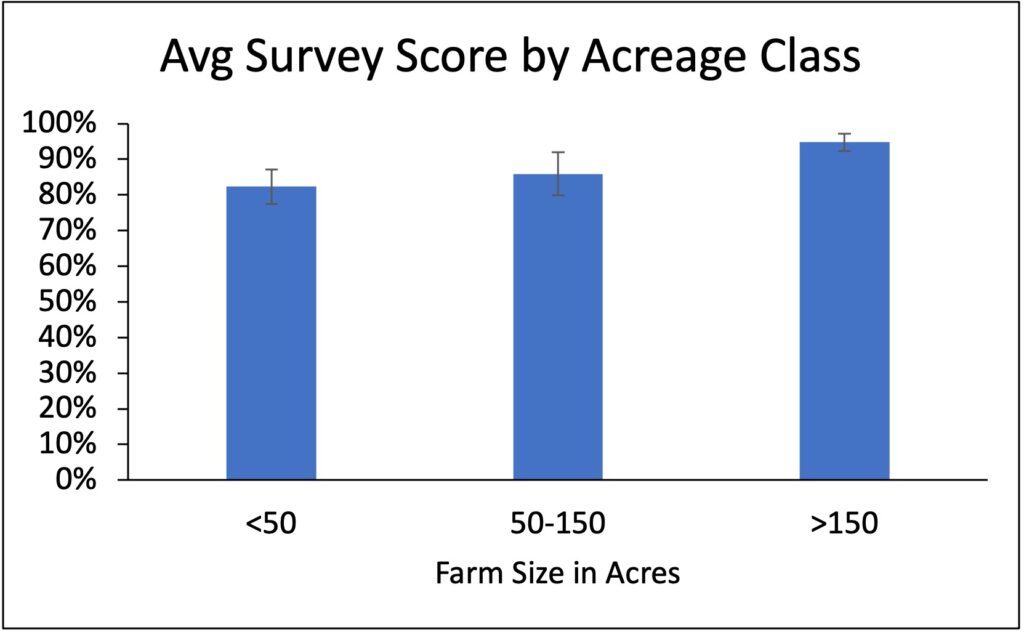
10. The 100 beekeepers listed in (3 above) will attend winter meetings in 2019, 2020 and 2021 where project results are presented, and follow-up surveys completed about annual management and pollination practices.
100
569
April 30, 2020
Completed
October 31, 2021
During the last 2 years of the project, beekeeper meetings were held on 3/9/21 (61 beekeepers), 4/11 (416 beekeepers), 11/19 (68 beekeepers), 1/15/20 (112 beekeepers), and 2/1/20 (165 beekeepers). Beekeepers learned about our research results that showed the factors involved in colony decline while pollinating blueberries, as well as our work on the fungicide effects on bee larvae.
As of October 2021, beekeeper audience participation in project meetings and surveys totaled 1,114 individuals who received information from this project. Presentations were made at chapter and state meetings of the NJBA, at the Delaware Beekeepers Association, and virtually at larger meetings. However, because of Covid considerations and restrictions, interactive in-person follow-up surveys were not possible during this time, and will be postponed until mid to late 2022 to early 2023.
Milestone Activities and Participation Summary
Educational activities:
Participation Summary:
Learning Outcomes
Through small group in-person meetings, the beekeepers and growers agreed on the following set of practices that the growers would try to adhere to:
- Applying the first in-bloom fungicide for anthracnose control shortly BEFORE the bees are put into the fields.
- Use of ground applications to replace aerial spraying during pollination.
- Making fungicide applications at night after the bees have stopped foraging, leaving only dry residue in the morning.
- Avoiding the over-spraying of hives and reducing pesticide drift when fungicides are applied.
- Use of single compound tank applications, and avoiding tank mixes and adjuvants.
- Backing off the use of pre-bloom insecticide use so that the last pre-bloom insecticide is used no less than 3 days pre-bloom.
Performance Target Outcomes
Target #1
20
Change types of pesticides used, Change the timing of applications, Reducing tank mixes to single materials, Applications made at night when possible
3,000 acres of production
Decreased number of pesticide applications, Fewer queenless hives and improved colony health during pollination
20
Through individual consultations various growers instituted the following practices: 1) Applied the first fungicide application prior to bringing bee into the fields in place of shortly after; 2) Applied fungicides in the evening after bees stopped foraging; 3) Considered and chose least toxic insecticides if insecticides had to be used; 4) Avoided aerial applications during bloom; 5) Did not tank mix materials
3000 (estimate based on interviews)
Hive health as the principal measurable benefit, varied by year, but growers who produced blueberries on 3,000 acres did try to adhere to at least 1 recommended practice not previously done. Hive health also varied by the farm site. Pollination economics is an emerging benefit for some individual beekeepers, which will also be used to help change grower practices. About 30% of the rental hives for the coming season will have a rental price which will be indexed to the hive health on those farms the beekeeper serviced during the previous season. The recommendations which came out of this project will be encouraged by the beekeepers, and good hive health coming out of pollination will reflect lower pollination fees during the following season.
Actual outcomes have been identified by examining commercial beekeeper hives, interviewing commercial beekeepers and fruit growers, monitoring sentinel hives placed on commercial farms. and working with a steering committee of key growers and commercial beekeepers. Since we have not been able to have in-person meetings for almost 2 years (starting in March 2020), we have not been able to do any formal in-class 'post-learning' or 'outcome' surveys. Nor have we been able to create the instructional video on hive health that was previously planned. Given that we will continue working on related projects under different funding, that work will follow in 2022-'23.
Key outcomes to date have been:
- A set of bee safety recommendations tailored to blueberry production during the pollination period.
- A Pollinator Safety Chapter in the annual Commercial Blueberry Pest Control Recommendations for New Jersey
- A new and ongoing formal relationship between commercial beekeepers and blueberry growers that focuses on honey bee health, partially realized by both organizations financially contributing to honey bee health research.
- Significant new research on the effects of fungicides on honey bee health, to be published.
Additional Project Outcomes
New working collaborations include partnerships and/or funding from: The USDA EIPM program, which is funding a 3 year Honey Bee IPM program that will use the information gathered from this project in order to further grower and beekeeper practices to improve colony health. These collaborations also include ongoing work and funding from the New Jersey Blueberry/Cranberry Research Council, which continues to fund our honey bee work now that we have an established program. Collaborations also include the New Jersey Department of Agriculture, which continues to fund supporting work, and includes collaboration with the New Jersey Beekeepers Association and it's individual chapters. These organizations continue to support work which has grown out of this project, including: 1) Work on how honey bee foraging behavior is affected by fungicides, 2) Work on screening for fungicide and acaricide toxicity to honey bee larvae, and 3) Delivery and education in a Honey Bee IPM Program.
Some of the outcomes of this project are still in progress. These include: 1) An instructional video on honey bee health and how pesticides effect honey bee colonies - Primary audiences are a) commercial fruit growers but will also include b) the general public. 2) Additional presentations and extension publications on pollination, pesticides and bee health. and 3) Refereed journal articles resulting from this research. Additional research and publications on the research that was "spun off" from this project, including 1) Information on fungicide toxicity to honey bee larvae; and 2) Behavior effects of fungicides on foraging behavior.
